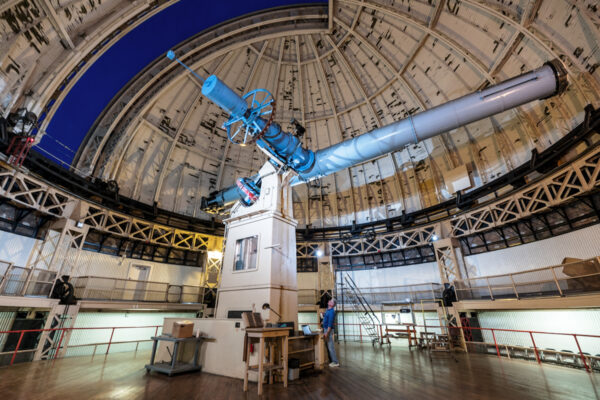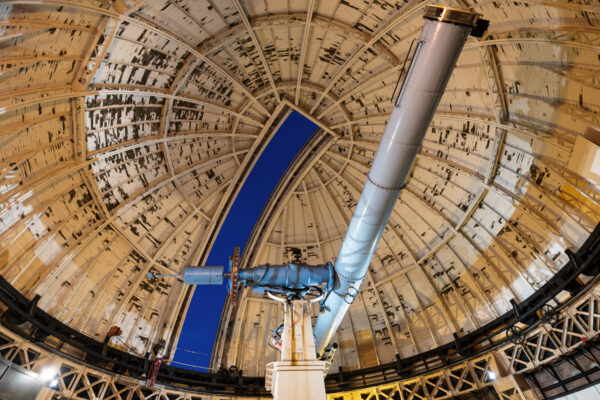When you think about stargazing, Pittsburgh might not be the first place that you’d think to head. However, the Allegheny Observatory has been doing astronomical research from within the city since 1859, and the work continues today despite being in Pennsylvania’s second-largest city.
And, on Thursday and Friday nights between April and October, free tours are offered of this historic and fascinating space.
Somehow, during my years traveling in PA, I had never had the opportunity to tour the Allegheny Observatory until the spring of 2023, and I found it to be one of the best free things to do in Pittsburgh.

The Allegheny Observatory was founded in February 1859 in what was then Allegheny City and, in 1867, it was donated to what is now the University of Pittsburgh (which still owns the observatory today).
In 1900, the cornerstone was laid for a new observatory a few miles further from the city within present-day Riverview Park. This Classic Revival-style building sits on the hilltop and is quite impressive to look at from the exterior. Since 1911, this has been the permanent home of the Allegheny Observatory.
When the observatory was first conceived, one of the goals was the education of the public, something that continues today with their public tours.

Tours last about two hours, running from 8-10 pm on select nights. While reservations are required (more on that below), tours are totally free.
Tours of the observatory start in the lecture hall right inside the front entrance.

In this space, docents offer a bit of the story of the observatory and its importance in history. There is also a bit of a discussion of the cosmos and some of the work being done there.
I found this all to be quite interesting, but others, especially younger kids, might find it a bit dry and it might go over their heads. The observatory does recommend the tour only for those 7 and older, but you might want to keep your kids (or your own) attention span in mind when booking a tour.
After an overview of the site, tours head to the main floor rotunda, which features a statue of astronomer John Brashear (who was once the observatory’s director) the large telescope’s original lens, and a beautiful stained-glass window featuring the Greek goddess Urania.

I really found the discussion here of the symbolism in the window to be quite interesting, as well as talking about some of the items within the space.
In a small room next to the rotunda, you’ll find possibly the two most interesting historical pieces within the Allegheny Observatory.
In 1869, the observatory’s first director, Samuel Langley, who was later an aviation pioneer, created “Allegheny Time”, which was the first standardized time and used astronomical measurements done at the observatory to actually keep track of time.

The Allegheny Observatory would send out a telegraph signal at exactly noon each day, which railroad stations across the country would set their clocks to. At one point, this time service was sent to 300 stations across the country. The signal sent at noon on November 18, 1883 is still the basis for standard time today.
It is these two clocks that you’ll find within the small room along the tour route. If you didn’t know what they were, they’d just look like two antique clocks, but after hearing the story of their impact on the country, I found them quite fascinating to see.
After viewing the clocks, the tour heads upstairs into the largest dome at the Allegheny Observatory. This area is home to their 30-inch Thraw Refactor, which is 47 feet in length.

This impressive telescope is one of the largest in the world and has been staring into the cosmos for over 110 years. Over that time, it’s created more than 110,000 glass plate exposures.
Even today, it still looks out at the stars every clear night of the year as it searches for new planets around distant stars.
While this isn’t the kind of telescope you can look through, docents offer a great overview of the telescope’s history, technology, and purpose. It’s also really neat to see the dome above spin open and to see how the floor moves up and down independently of the telescope.

The next stop on the tour is one of the smaller domes, which is home to the Fitz-Clark Refractor. When this telescope was built in 1861, it was the third-largest telescope in the world, and it was the primary telescope at the observatory when it first opened.
Today, however, it is primarily used so that those touring the observatory can get a glimpse into some of the celestial bodies above. And, if you’re lucky enough to visit on a clear night, as I was, you’ll have a chance to see a couple of different objects through the telescope.
During my visit, we first looked at the moon, and then at two stars within the Big Dipper, both of which were quite impressive to see through such a fine telescope.

While we went around the room and each person had a turn looking through the telescope, docents offered a bit more information about the night sky and the history of the area.
Tours here are also held on nights without clear skies. On cloudy nights, you don’t get to look through the telescopes, but you still get to tour the site, and more information is given about the work in the observatory, so it’s still a worthwhile program to attend. In fact, I’d love to go back again to hear more about the site on a cloudy night.
Overall, I had a fantastic time touring the Allegheny Observatory in Pittsburgh, and my only regret is that it took me so long to check it out. If you have any interest in astronomy, this is definitely a must-visit spot in the city. (You’ll also want to check out the nearby Moonshot Museum if the subject interests you.)
How to Register for Tours of the Allegheny Observatory

Tours of the Allegheny Observatory in Pittsburgh’s Riverview Park are held every Friday night from April through October and every Thursday night from April through August. All tours start at 8 pm and last until 10 pm.
To register for a tour, call 412-321-2400 or visit their website. When I called, I had to leave a message, but I got a call the next day about scheduling a tour.
You must pre-register for the tours, though you can call as late as 5 pm on the day of the tour if spots are still available. Still, I recommend calling or booking online at least a few days in advance to ensure you’ll get a spot. Do NOT simply show up at the tour time expecting to get a spot.
There is no charge to tour the observatory.
Looking for more spots to visit nearby? Check out Pinball Perfection, Randyland, and my favorite photo spots in Pittsburgh. And, if you like looking at the stars, plan a trip to Cherry Springs State Park, the darkest spot in PA.



 "
"




Hi, do you recall if the Observatory is wheelchair accessible? I know you mentioned different floors, so I was curious about ramps/elevators. Thanks!
I would recommend contacting the Allegheny Observatory directly to ask (The contact info is near the bottom of the article). There were a fair number of steps (including at the entrance that we went in), and I did not see an elevator. However, it’s possible there is one.